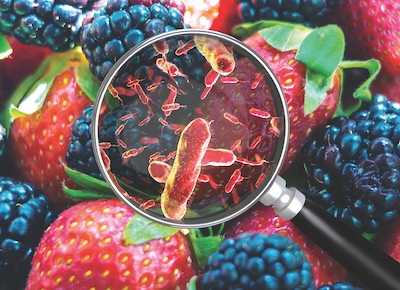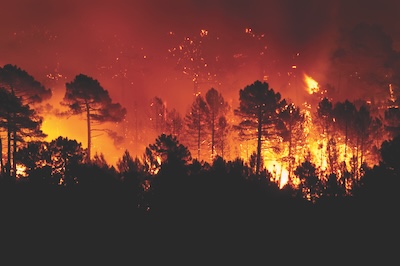
Climate change’s impact on food safety
April 16, 2025
By Vaishnavi Dandekar
Strategies to handle food safety-related risks posed by global warming
 Climate change is causing frequent weather disruptions, which can provide more favourable breeding grounds for foodborne pathogens like e.coli and listeria. Photo © Giovanni Cancemi / Adobe Stock
Climate change is causing frequent weather disruptions, which can provide more favourable breeding grounds for foodborne pathogens like e.coli and listeria. Photo © Giovanni Cancemi / Adobe Stock In the face of climate change, food safety is emerging as a critical concern. Shifting environmental patterns are introducing new challenges to the food supply chain, demanding an urgent response from both industry and regulatory bodies. To delve deeper into these complexities, I spoke to Amy Proulx, a professor and academic program co-ordinator of Culinary Innovation and Food Technology at Niagara College, and Meghan Griffin, food recall specialist at the Canadian Food Inspection Agency (CFIA).
Food-borne pathogens
“Climate change provides a compelling lens through which to examine food safety, with numerous systemic dynamics influencing how companies, organizations, and value chains tackle food safety challenges,” says Proulx.
She emphasizes the interplay between shifting weather patterns and the prevalence of foodborne pathogens. These pathogens thrive in changing environmental conditions, and their distribution patterns are being altered by climate change, which can result in more frequent outbreaks.
“The changing weather patterns are already having a drastic impact on food safety and contamination risks,” Proulx notes. “For example, changes in rainfall can lead to flooding, which disrupts irrigation systems and exposes food products to contaminated water sources.”
These shifts can weaken preventive control measures that companies use to manage risks in their production processes, ultimately compromising the safety of food.
The relationship between climate change and pathogen spread is well documented. In Canada, the Public Health Agency of Canada and CFIA track these dynamics through various surveillance programs, including the National Microbiological Monitoring Program. Between 2017 and 2022, results indicated that up to 99.7 per cent of domestic and imported food products tested were compliant with food safety standards. However, the growing frequency of climate-related disruptions is challenging this compliance, requiring enhanced vigilance and adaptation strategies.
Impacts on supply chain
The Canadian food supply chain is increasingly vulnerable to climate-induced disruptions.
“In western Canada, wildfires can cause road closures, delaying product deliveries and extending transit times, which affects the shelf life and safety of food items,” Proulx adds.
CFIA plays a critical role in monitoring these disruptions.
“Our agency works closely with industry partners to address food safety risks related to transportation delays, including those caused by climate events like wildfires and floods,” explains Griffin.
The challenge lies not only in managing the immediate effects of such disruptions, but also in ensuring that food remains safe for consumption after being delayed in transit.
Investment-related challenges
To combat these risks, significant investment in food safety infrastructure is essential. However, Proulx points out food companies often view food safety programs as a cost rather than essential.
This trend is especially concerning during periods of economic stress, when companies under financial strain might deprioritize food safety measures.
This phenomenon is problematic because a reactive approach to food safety can result in severe consequences for public health. Therefore, Proulx advocates for a more proactive stance, where food safety is integrated into the organizational culture as an essential part of the food production process, rather than a regulatory burden.
Innovations in food safety
Despite these challenges, there are promising innovations in food safety technology.

Natural disasters like wildfires and flooding impact food safety. Climate change is exacerbating these types of emergencies. Photo © JAH / Adobe Stock
“There have been many advancements in rapid analysis and pathogen detection, including innovations in lower-level pathogen detection,” Proulx explains.
These innovations can help identify contamination before it becomes widespread, allowing for a more targeted and efficient response. AI is also playing an important role in enhancing food safety protocols.
Blockchain technology has also emerged as a potential tool for enhancing traceability.
“While blockchain offers significant promise in tracking the journey of food products, the initial investment required can be prohibitive for small companies,” Proulx admits.
However, there are scalable solutions, such as GS1, that allow smaller companies to adopt blockchain-like traceability features without the high upfront costs.
Cross-sector collaboration
The role of public awareness in food safety cannot be overstated, according to Griffin.
She emphasizes that increased awareness, such as through media coverage, often triggers individuals to check their homes for recalled products, thus preventing further exposure to unsafe food. Further, Griffin stresses that food safety is a collective responsibility.
Future of food safety
Looking ahead, both Proulx and Griffin agree continuous innovation and vigilance will be required to navigate the increasing challenges posed by climate change.
“The future of food safety will likely see greater integration of AI and machine learning, which will help predict and mitigate foodborne illness outbreaks before they occur,” says Proulx.
These technologies will enhance the ability to forecast food safety risks and facilitate more rapid, precise responses. Griffin also emphasizes the importance of continuous improvement in food safety systems.
“Food safety is not a one-time achievement but a continuous process. We need to constantly adapt, looking for new ways to improve safety and efficiency,” she says.
This ongoing commitment to innovation, collaboration, and public awareness will be vital in maintaining Canada’s food safety standards in an era of climate uncertainty.
Adapting standards
Canada’s food safety standards, administered by Health Canada and enforced by CFIA, are regularly updated based on emerging scientific data.
“When new risks emerge, standards are reviewed and revised to ensure they reflect the latest scientific evidence,” says Griffin.
This adaptive approach ensures that the food safety system remains resilient in the face of new challenges, including those posed by climate change. In line with these updates, CFIA has been exploring the integration of predictive tools to assess climate change risks and vulnerabilities.
“We are working with the Public Health Agency of Canada to conduct integrated risk assessments, focusing on emerging zoonotic threats and public health priorities,” says Griffin. These efforts aim to strengthen Canada’s ability to address future food safety challenges proactively.
As climate change impacts Canada’s food system, the collaboration between regulatory bodies, the industry, and public will be essential in maintaining food safety standards. Through the use of innovative technologies, increased investment in infrastructure, and proactive risk management strategies, Canada can navigate the evolving food safety landscape. As both Proulx and Griffin assert, the road ahead will require continuous effort and adaptation, ensuring a safe and sustainable food supply for all Canadians.
This article was originally published in the Feb./Mar. 2025 issue of Food in Canada.